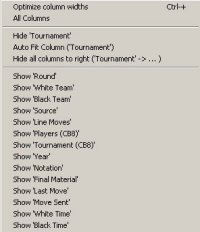 |
ChessBase Reviews |
Last updated 11 April 2005

ChessBase 9 Part 2
This is my second article on the new ChessBase 9 program and continuing from my last article I must say that I am still really impressed with the program. The facilities which this type of program make me wonder how we ever managed to keep track of our games and research in Correspondence Chess before ChessBase provided such tools for us. The simple answer is that we spent a lot more hours devoted to each game with little time left for us to enjoy anything else in life. Well at least that is true for me as I was never a great player.
Anyway lets get back to having a look at the new ChessBase 9. At the heart of the matter ChessBase is simply a tool which I use to search for, and play through games which might be of interest when looking for possible plans in my own games. ChessBase 8 was great for this but CB9 does everything faster. Searching, sorting and classifying take less time than with CB8. This is not the end of the story though. The database window with the list of games looks pretty much the same with the player names, tournament, ECO code, etc, but delving slightly deeper reveals some subtle enhancements which most users will find very useful.


For example if you hover the mouse over a ECO code you get a box appearing with the name of the variation in plain English. It is the attention to fine detail like this that makes the program more user friendly. I for one find it easier to remember plain English variation names rather than ECO codes.
In the database list each of the columns is now a separate entity pretty much like a spreadsheet or standard database. CB8 users will remember for example that the first column contained the game number, the name of the player who had White and the name of the player who had Black, and their grades.
In CB9 this one column is split into 5 separate columns. OK I can see you asking what difference that makes as you still end up with the same information displayed in both instances. True, but the difference is what you can now do with the information because of the new format.
Clicking on the header tab for any particular column will now reorganise, or rather sort, the whole database by that field. So for example, I can instantly sort the database alphabetically by the name of the player with the White pieces or the player with the Black pieces depending on my preference. I could sort it with the highest graded player with the White pieces at the top or do the same for the player with the Black pieces. I could sort the whole database by the ECO code. All of this at the click of a mouse button and I can see the database displayed in whichever manner suits me best.

Right clicking the mouse on a column header will bring up another menu.
So from the Tournament tab you could now choose to hide that particular column and the tournament names would no longer appear in the database list. The same applies for the other columns. In essence you now have the ability to decide which lists of information appear in your database list.
You can also highlight a game, by left clicking the mouse on it, and then holding the left mouse down, drag that particular game to a different place in the database list. This allows you to manually sort a database if you wish, and is particularly useful if you wish to group a number of games together for easy reference or printing or game merging purposes.
In essence CB9 has a lot more user functionality to let you decide how you want your information displayed.